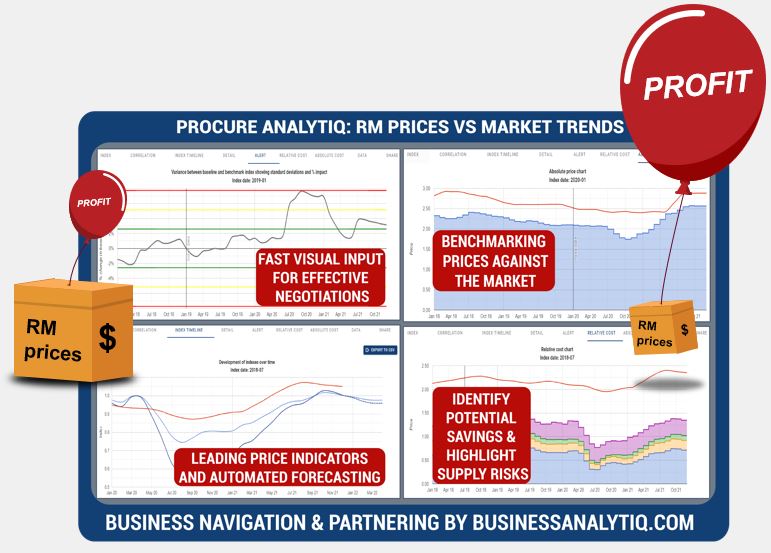Triple superphosphate (TSP) price April 2024 and outlook (see chart below)
- Global:US$0.43/KG, unchanged
- North America:US$0.47/KG, unchanged
- Europe:US$0.47/KG, unchanged
- Africa:US$0.37/KG, unchanged
- Northeast Asia:US$0.63/KG, unchanged
Business Analytiq assumes no responsibility or liability for any errors or omissions in the content of this site. The information contained in this site is provided on an “as is” basis with no guarantees of completeness, accuracy, usefulness, or timeliness.
Triple superphosphate (TSP) price index
This post is a summary of the Triple superphosphate (TSP) price developments. The price developments of Triple superphosphate (TSP) are expressed in US$ prices converted FX rates applicable at the time when the price was valid. Triple superphosphate (TSP) price index developments are calculated from multiple separate sources of data to ensure statistical accuracy.
The outlook for Triple superphosphate (TSP) prices, on the second tab, is generated from different inputs including:
- Very recent price developments of immediate cost drivers of Triple superphosphate (TSP) prices
- Recent price developments of underlying feedstocks which drive the price of Triple superphosphate (TSP)
- Market futures for both cost drives and feedstocks of Triple superphosphate (TSP) prices
- Adjustment of current supply/demand imbalances in the Triple superphosphate (TSP) market
- Longer term trends in likely demand conditions
Further information on the Triple superphosphate (TSP) price index
What is Triple superphosphate (TSP)
Triple superphosphate (TSP) is a type of fertilizer that is commonly used to provide crops with a high level of phosphorus. It is made by reacting phosphate rock with phosphoric acid to produce a product that is rich in phosphorus.
TSP is a highly concentrated fertilizer, with a phosphorus content of around 46-48%, which makes it an excellent source of this essential nutrient for plants. It is commonly used to fertilize crops such as cereals, oilseeds, and sugarcane, among others.
TSP is usually applied to the soil, either by broadcasting or banding, and is then incorporated into the soil to provide the plants with the necessary nutrients. It can also be used as a starter fertilizer to provide young plants with the phosphorus they need to establish a healthy root system.
TSP is an important source of phosphorus for many farmers around the world, and its production and use are closely monitored to ensure that it is used in a responsible and sustainable way.
How is Triple superphosphate (TSP) produced
Triple superphosphate (TSP) is produced through a chemical reaction between phosphate rock and phosphoric acid. The process involves the following steps:
Mixing
Phosphate rock, which is the raw material for TSP, is mixed with a small amount of water to form a slurry. The slurry is then mixed with sulfuric acid to produce a mixture called superphosphate.
Reacting
The superphosphate is then reacted with phosphoric acid to produce TSP. This reaction produces calcium sulfate (gypsum) as a byproduct, which is removed from the product through a filtration process.
Drying
The TSP is dried to remove any remaining moisture and to make it easier to handle and transport.
Granulation
The dried TSP is then granulated to produce uniform-sized particles, which makes it easier to apply to crops.
The final product is a grayish-white powder or granule that is rich in phosphorus and is used as a fertilizer for crops. The quality of TSP depends on the quality of the phosphate rock used, the concentration of phosphoric acid used, and the production process employed.
Which countries produce the most Triple superphosphate (TSP)
Triple superphosphate (TSP) is a fertilizer that is produced by reacting phosphate rock with phosphoric acid. The production of TSP is primarily concentrated in a few countries, and the top producers are:
China
China is the largest producer of TSP, accounting for about 55% of global production. The country’s high production is attributed to its large population and agriculture industry.
Morocco
Morocco is the second-largest producer of TSP, accounting for about 14% of global production. The country has significant reserves of phosphate rock, which is the primary raw material used in the production of TSP.
India
India is the third-largest producer of TSP, accounting for about 11% of global production. The country is a major agricultural producer and uses a significant amount of fertilizers, including TSP.
Russia
Russia is the fourth-largest producer of TSP, accounting for about 6% of global production. The country has significant reserves of phosphate rock and uses TSP in its agriculture industry.
United States
The United States is the fifth-largest producer of TSP, accounting for about 5% of global production. The country’s production of TSP has declined in recent years due to increased competition from other countries and changes in the fertilizer market.
Other significant producers of TSP include Brazil, Egypt, Indonesia, and Vietnam.
What types of TSP are there
There is typically only one type of triple superphosphate (TSP) fertilizer, which is produced by reacting phosphate rock with phosphoric acid. However, there may be some variations in the production process and in the quality of the product based on the specific raw materials and manufacturing methods used.
One such variation is the water-soluble TSP, which is a more finely ground version of TSP that dissolves more easily in water. This allows for easier and more efficient application of the fertilizer and better absorption by the plants. Another variation is the coated TSP, which is TSP coated with a polymer to control the release of the fertilizer in the soil, allowing for a more controlled and consistent supply of nutrients to the plants over a longer period.
Additionally, TSP can be blended with other fertilizers to create customized blends with specific nutrient compositions to meet the needs of different crops and soil types. For example, TSP can be blended with nitrogen and potassium fertilizers to create a complete NPK (nitrogen, phosphorus, potassium) fertilizer blend.
Overall, TSP is a highly concentrated source of phosphorus that is used to promote plant growth and increase crop yields. While there may be some variations in the production process and application methods, there is typically only one type of TSP fertilizer.
How big is the Triple superphosphate (TSP) market
The global triple superphosphate (TSP) market size was valued at USD 2.8 billion in 2020, and it is expected to grow at a compound annual growth rate (CAGR) of 3.5% from 2021 to 2028. The market is driven by the increasing demand for food due to the growing population, which has led to an increase in the use of fertilizers to enhance crop yields.
The market is dominated by the Asia Pacific region, which accounted for the largest share of the global TSP market in 2020. This is attributed to the high agricultural production in countries such as China and India, which are the largest consumers of TSP in the world.
The use of TSP is also increasing in other regions, such as North America, Europe, and South America, as farmers seek to improve crop yields and increase efficiency in agriculture. The market is highly competitive, with several players operating in the global TSP market, including major fertilizer manufacturers, such as Nutrien, Yara International, and The Mosaic Company, among others.
Overall, the global TSP market is expected to continue to grow in the coming years, driven by the increasing demand for food and the need to improve agricultural productivity.
According to https://oec.world/ :
Superphosphates, in packs >10 kg are the world’s 1807th most traded product.
In 2020, the top exporters of Superphosphates, in packs >10 kg were China ($294M), Morocco ($263M), Israel ($183M), Egypt ($93.2M), and Netherlands ($57.3M).
In 2020, the top importers of Superphosphates, in packs >10 kg were Brazil ($321M), United States ($81.9M), France ($66.5M), Indonesia ($62.7M), and Australia ($34.3M).
Further reading
Business Analytiq
BE THE FIRST TO SEE RISK AND OPPORTUNITY!
BusinessAnalytiq provides unlimited market trend data and an online tools to track market developments, key benchmarks & leading indicators.
BusinessAnalytiq leads to price visibility, better negotiations, easier budgeting and forecasting, lower raw material prices, and improved better internal and external communication. BusinessAnalytiq will decrease risk and higher profit.

Where does the data come from?
- The source of the data are exclusively public non-confidential sources. We have no access to primary data
- This the index trend of the price trend of the "product category" in general, and not a single specification of the product in particular
- The data is a combination of contract and spot pricing
- Our algorithms are set up to eliminate significant product mix impact on the reported price
- We combine public publications, import/export records, trading prices, company announcements, magazine articles, tweets, and other sources of ad-hoc public information.
- The chart shows the our best approximation of the market trend based on our algorithm interpretation of the signals
- For most indexes we have multiple sources and we focus on using statistically-correlated sources
- As a function of our automation, it is likely that recent trends will be adjusted as we discover more information. So, for example, the price trend for February 2024 will be first calculated in February 2024 and adjusted in March, April and May 2024.
- We will update the data trend as more information becomes available, and this means that recent trends will always be adjusted as we get more data available
- The algorithm will regularly revise our understanding of market trends, and indicated market trends may change
- The data is presented in US$. The UOM of measure is shown in the Index list table
- Our automated software and we do our best to create an accurate representation of the trend
Where does the data NOT come from?
- We do not purchase data from any other source and republish it.
- We will not purchase data from any other source and republish it
- We do not extrapolate trends, even for the forecast. We look for other market signals and leading indicators
What data should our company use?
- If you are making decisions driving significant share of profit, we always recommend that you buy data from the companies who invest in direct primary market access such as ICIS, amongst many others
- Our data, at best, represents an estimate of the market trend based on public information
- We have no direct access to the market, and we do not interview suppliers and customers
- Our automated analysis tools in the online software are set up to combine our data with other sources of data
- We do not recommend that you use our data for direct price mechanisms, as we may change and improve the data trends over time, including historical data
What does the quality indication in the main menu mean?
- Quality level A: Data is from a reliable and confirmed source
- Quality level B: Data is from multiple credible sources and there are no major statistical inconsistencies between them
- Quality level C: Data is from multiple credible sources and there are some statistical inconsistencies between them
- Quality level D: Data is from a single credible source, but we cannot verify the data
- Quality level E: Data is either:
- From a single source, which we consider reliable, but we cannot verify the data.
- From 2 or more sources which have some periods of contradicting trends.
- Quality level F: Data is from a single source which we consider indicatively correct, but the data is anecdotal and we cannot verify the data.
What are the disclaimers?
- We assume no responsibility or liability for any errors or omissions in the content of this site.
- The information is provided on an “as is” basis with no guarantee of completeness, accuracy, usefulness, fitness for purpose or timeliness.
- By their nature, outlooks are always uncertain
How often do we update the data?
- We aim to update the data series on the 9th and 24th of each month (but we do not always make it for each chart)
- The data for the current month and recent history are fine-tuned over time.
What are we doing to improve the data?
- We are continually improving our data collection and processing methods
- Pricing data will be updated from time to time as we improve the accuracy
- We are reviewing all data sources in the first half of 2024.
- There will be continuous fine-tuning of the trend and forecast algorithm as part of that.
- The key focus in 2024 is to add many additional indexes
How can i give feedback on the data or request for new indexes
- Feel free to contact us if you have a specific request. You can reach us via the Contact us page

